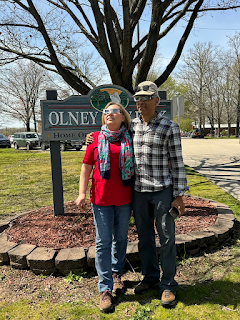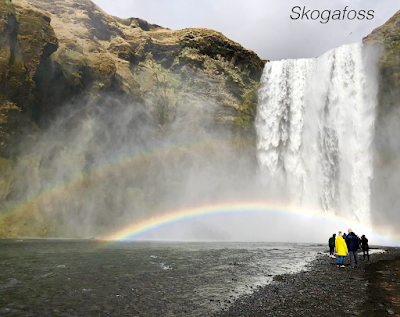2024 Solar Eclipse: Nature's Cosmic Spectacle
We've been eagerly planning our first trip of the year to see the total solar eclipse on April 8, 2024. We've known where to go to see it best for a while, but we've been worried about the weather. We needed clear skies to see the total eclipse properly.
We were well-prepared for this second eclipse event. We had planned where to go, how to get ready for the trip, what to look out for, and how to avoid heavy traffic afterward. The first eclipse we experienced was just a few years ago, on August 21, 2017, in Lincoln, Nebraska. The total eclipse lasted only 1 minute and 24 seconds, but it left us deeply impressed. Right then and there, we knew we wanted to experience another one.
NASA published the path of the eclipse which continued from Mexico, entering the United States in Texas, and traveling through Oklahoma, Arkansas, Missouri, Illinois, Kentucky, Indiana, Ohio, Pennsylvania, New York, Vermont, New Hampshire, and Maine. Small parts of Tennessee and Michigan would also experience the total solar eclipse. The eclipse would enter Canada in Southern Ontario, and continue through Quebec, New Brunswick, Prince Edward Island, and Cape Breton.
I prepared four travel plans to ensure flexibility and minimize the risk of encountering cloudy skies. Spanning a considerable distance from our home in Minnesota to various destinations, including Ohio, Indiana, Missouri, and Illinois, I monitored the weather closely. Eventually, we chose southern Illinois, as the forecast there appeared more favorable. Positioned along the centerline of the path of totality, Carbondale and Southern Illinois University promised an impressive duration of 4 minutes and 9 seconds of totality!
We drove to Illinois, specifically Bloomington-Normal, where we rested for the night and prepared for the upcoming spectacle. Despite this location offering only 96% eclipse coverage, the 4% difference felt substantial, like the contrast between night and day.
The next morning, we precisely studied maps to pinpoint the ideal spot for witnessing the eclipse. It had to fall within the 100% eclipse path, be no more than a three-hour drive away, have minimal cloud cover, and not be overly crowded. With invaluable guidance from the hotel concierge, we settled on Olney, Illinois - a relatively small town in southern Illinois with a population of around 7,250 people. Knowing it had a charming city park, we made our decision.
Our journey from Bloomington to Olney proceeded remarkably smoothly. The majority of travelers were making their way to Mount Vernon, IL, and Carbondale, IL, drawn not only by the eclipse but also by the attraction of a grand celebration. This festivity took place predominantly in a sports stadium, with extensive news coverage and engaging explanations of the eclipse by former space astronauts.
We wanted a peaceful spot in a park to watch the total eclipse and enjoy the surroundings - the birds, the shifting shadows, and the sky. Olney City Park was just what we were looking for.
When we arrived, campsites were already set up, and everyone was in a festive mood. Some people lounged in folding chairs or sprawled out on picnic blankets, all with coolers stocked with drinks and snacks. Many brought their pets along, and I wondered how they would react during the total eclipse. Kids ran around or played on the playgrounds nearby. We found our spot and settled into our folding chairs. The weather was sunny and gorgeous as we put on our glasses and eagerly awaited the cosmic spectacle to unfold. The moon had begun to cover a portion of the sun's surface.
 Gradually, the Sun transformed into a concave half-circle, then into a slender sickle shape. The path of the moon spanned from 5 to 11 o’clock. Yet, the Moon's progress was persistent, and in an instant, the Sun's disk vanished. We removed our glasses, stepping into the spooky twilight zone. It wasn't quite like sunrise or sunset, nor was it complete darkness. We had experienced something similar before but with less time of totality. This time, the spectacle seemed more profound and captivating.
Gradually, the Sun transformed into a concave half-circle, then into a slender sickle shape. The path of the moon spanned from 5 to 11 o’clock. Yet, the Moon's progress was persistent, and in an instant, the Sun's disk vanished. We removed our glasses, stepping into the spooky twilight zone. It wasn't quite like sunrise or sunset, nor was it complete darkness. We had experienced something similar before but with less time of totality. This time, the spectacle seemed more profound and captivating.
As we looked to the sky, the moon, resembling a black disk, covered the sun's disk, revealing the corona of the sun. Normally hidden by the sun's bright light, this corona is the sun's outer atmosphere, stretching millions of kilometers into space. It was truly astonishing to witness it firsthand.
During the total eclipse, we observed bright spots encircling the edge of the Moon's silhouette. These spots result from sunlight filtering through valleys and gaps between mountains on the Moon's surface. The effect resembles a string of glowing beads encircling the dark disk of the Moon, giving rise to the name 'Baily's beads.' Francis Baily first described them during the total solar eclipse of May 15, 1836. What a truly special moment it was.
We observed reddish dots and loops around the edges of the moon’s shadow. These prominences are massive eruptions of hot gas (plasma) from the Sun's chromosphere into its corona. They can extend thousands of kilometers into space and are held in place by the Sun's magnetic field. The sun is currently experiencing a period of high activity. During times of heightened solar activity, the sun's corona can display more dynamic features, including loops, streamers, and prominences, making it especially captivating during total solar eclipses. That's what we recognized as the large red spots and loops (picture credit to WCIA 3, which shows the total eclipse, Baily's beads, and prominences).
Other observations included a rapid drop in temperature, birds singing loudly, and some individuals spotting bats as they began their night activities. I found the shadows of the trees to be particularly striking during the eclipse. It is known that the edges of the shadow can appear sharper and clearer than usual due to the decrease in ambient light. I was hoping to see the effect of taking pictures with my phone. Left is the shadow of the tree at the beginning of the eclipse and right before totality.
During an eclipse, the sharpening of shadow edges is primarily caused by the drastic reduction in ambient light due to the moon partially or fully blocking the sun. This sudden decrease in illumination leads to more distinct boundaries between areas of light and shadow.
In contrast, during the evening or at sunset, there's a gradual decrease in sunlight as the sun descends lower in the sky. Shadows may appear longer and softer as the light is scattered and diffused through the atmosphere. While you may notice some sharpening of shadow edges as the light diminishes, it's typically not as pronounced or sudden as during a solar eclipse.
An additional bonus was seeing the sky during totality. Jupiter was situated to the left, and Venus to the right (Picture credit: NASA/JPL-Caltech).
We could easily see Jupiter and Venus with our eyes.
We only had 3 minutes and 21 seconds to observe the total eclipse and our surroundings. It wasn't enough time, but the moon continued its path, revealing the disk of the sun once again with another highlight: the diamond ring. The "diamond ring effect" is a phenomenon that occurs during a total solar eclipse, just before the total phase begins or just after it ends. It appears as a bright spot of sunlight, resembling a diamond ring, shining around the edge of the Moon. It's quick but beautiful. We saw the effect at the end of the eclipse.
The Moon continued its journey, and the full Sun gradually emerged, marking the end of the eclipse. Daylight returned, marking the end of this planetary spectacle (picture credit to WCIA 3).
We scored an additional bonus point by finding ourselves in southern Illinois at the start of April. With spring in full swing, temperatures were around 70°F! It couldn't have been more perfect. People thoroughly enjoyed the weather, adding to the excitement of the eclipse. We took our time before heading back home.
A friend sent me a picture of the eclipse cookies that Daniela has made, calling them "Sonnenfinsternis Kekse." It seemed like everyone was thrilled about this unique moment.

















